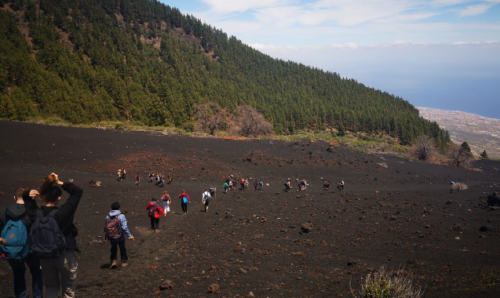Research Roundup: measuring volcanic emissions of sulphur dioxide
Research and impact 17 August 2020
Professor Mike Burton and PhD student Ben Esse from the Department of Earth and Environmental Sciences are contributing authors to a new article titled, ‘iFit: A simple method for measuring volcanic SO2 without a measured Fraunhofer reference spectrum’. Ben told us more about their research which provides insights into magmatic processes and monitoring volcanic activity.

We have created a new tool to help volcanologists to measure volcanic SO2 fluxes easily and accurately. Measuring the flux of SO2 is an important monitoring tool for volcanologists, as well as a way of helping to determine volcanic processes, so it is important that these measurements are as accurate as possible. Together with colleagues from the Italian National Institute for Geophysics and Volcanology (INGV) and the Geological Survey of Japan (GSJ), we have created a software tool that could help to make these measurements easier to do and more accurate than existing methods.
Article Abstract
Accurate quantification of the emission rate of sulphur dioxide (SO2) from volcanoes provides both insights into magmatic processes and a powerful monitoring tool for hazard mitigation. The primary method for measuring magmatic SO2 is Differential Optical Absorption Spectroscopy (DOAS) of UV scattered sunlight spectra, in which a reference spectrum taken outside the plume is used to quantify the SO2 slant column density inside the plume. This can lead to problems if the reference spectrum is contaminated with SO2 as this will result in a systematic underestimation of the retrieved SO2 slant column density, and therefore emission rate. We present a new analysis method, named “iFit”, which retrieves the SO2 slant column density from UV spectra by directly fitting the measured intensity spectrum at high spectral resolution (0.01 nm) using a literature solar reference spectrum and measured instrument characteristics. This eliminates the requirement for a measured reference spectrum, providing a “point and shoot” method for quantifying SO2 slant column densities. We show that iFit retrieves correct SO2 slant column densities in a series of test cases, finding agreement with existing methods. We propose that iFit is suitable for both traverse measurements and permanent scanning stations and could be integrated into volcano monitoring networks at observatories. Finally, we provide an open source software implementation of iFit with a user-friendly graphical interface to allow users to easily utilise iFit.
Ben Esse, Mike, Burton, Matthew Varnam, Ryunosuke Kazahaya and Giuseppe Salerno, ‘iFit: A simple method for measuring volcanic SO2 without a measured Fraunhofer reference spectrum’ Journal of Volcanology and Geothermal Research, 402 (2020), https://doi.org/10.1016/j.jvolgeores.2020.107000.
hazard mitigationiFitmass spectrometryRemote sensingscanningslant column densitiessoftwaresulphur dioxideUV spectroscopyvolcanic monitoringvolcanic processesVolcanology




Leave a Reply